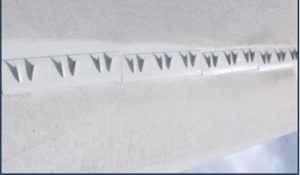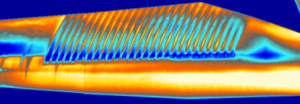Through our Marine Energy Engineering Centre of Excellence – MEECE – The Offshore Renewable Energy (ORE) Catapult collaborated with Anakata, Natural Power, Swansea University and the National Technical University of Athens to develop a streamlined process for designing and optimising the siting of enhanced vortex generators (VG) for wind turbine blades.
Vortex generators are aerodynamic devices that can be fitted to lift surfaces to create vortices and delay flow separation, with the use of VGs aiming to improve aerodynamic performance for wind turbine blades.
The partnership team was particularly interested in addressing the aerodynamically inefficient root region as well as the blade tip, and how the placement of vortex generators at these points can help to counteract the adverse aerodynamic effects of leading edge erosion.
During a field visit when infrared thermography was used, the partnership team identified significant areas of stall affecting the turbine blade which MEECE could correct.

Wind tunnel testing, high fidelity computational fluid dynamics (CFD) modelling and infrared thermography field measurements followed, after which vortex generators were developed and installed on a V52 wind turbine.
Field results from the subsequent performance assessment of the turbine – using LiDAR and supervisory control and acquisition (SCADA) data – showed that annual energy production (AEP) had increased by more than 5%. The analysis report can be downloaded here.

A further infrared thermography field visit, conducted post installation, helped to demonstrate the positive impact which the vortex generators exerted on airflows over the blade, delivering improved power performance.

The project’s combined approach has led to a step change improvement in the performance of VGs against current industry standards – they also represent an inexpensive means of increasing power production from wind turbines. This project’s results are therefore expected to have a profound impact on the industry, including its role in achieving net-zero.
Huw Griffiths, CEO, Anakata said:
“This collaboration has been a fantastic opportunity to combine aerodynamic excellence with new tools and apply them to deliver superb field results that not only aligned with the modelling, but delivered a fantastic increase in energy output as measured by industry standard methodologies. Delivering > 5% increase in annual energy production is a step change for the wind industry.”
Iain Dinwoodie, Head of Advanced Performance Engineering, Natural Power said:
“Natural Power has benefited from the collaboration by gaining insight into the cutting-edge research and development relating to aero-dynamic upgrades. We brought our experience in quantifying real world benefits to operational projects to validate the outcomes of the project and help identify the potential benefits to the industry. The collaboration between academia, SME, consultancy and innovation centre brought complimentary perspectives to the project and demonstrated our commitment to innovation.”
Marinos Manolesos,Honorary Senior Lecturer, Swansea University and Assistant Professor, National Technical University of Athens said:
“As academics, our pursuit of knowledge is propelled not only by curiosity but also by the desire to make tangible impacts. Through the fusion of cutting-edge experimental, numerical and field measurement tools, our research has enhanced the efficiency of wind turbines beyond current state of the art. It was a great experience to collaborate with all partners and see the development of the flow control devices from a laboratory exercise to an actual product.”
Magnus Harrold, Senior Marine Energy Technical Manager, ORE Catapult said:
“This is another great example of an Academic-Industry collaboration from our MEECE project, where the combined expertise has led to a new product with significant potential for the offshore renewable energy sector being developed. It has been particularly satisfying to see the results from the field tests agreeing with the performance improvement predictions made earlier in the project from wind tunnel testing and CFD modelling, confirming the applicability of the developed process.”